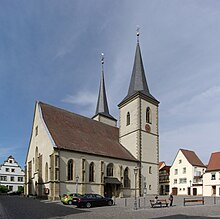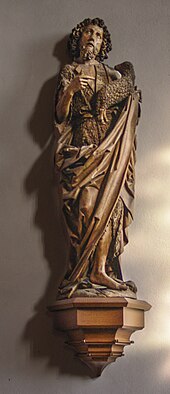St. Kilian (Haßfurt)
The parish church of St. Kilian , Kolonat and Totnan is the main Catholic church in the district town of Haßfurt in the administrative district of Lower Franconia in Bavaria . The Gothic pseudo-basilica (relay hall) contains two sculptures by Tilman Riemenschneider and some works from his workshop.
history
The first parish church stood on the site of today's knight chapel in the suburbs. In the 14th century the main church was moved to the northern edge of the market square. The old church was still used as a baptistery.

In 1339 the parish church was still in front of the city, in 1363 Pope Urban V granted an indulgence of 40 days in favor of the new building. Construction is to begin around 1350.
This first new parish church was replaced from 1390 (laying of the foundation stone) by today's relay hall. The two lower floors of the south tower were taken over from the old church.
The oldest construction phase is the choir . Subsequently, under Würzburg , Bishop Johann II von Brunn began work on the nave , the simple ribbed vault of which, however, was only drawn in at the end of the 15th century. The nave has a lot in common with the Marienkirche in nearby Königsberg . The unknown builder probably looked after both construction sites at the same time.
Around 1440, a somewhat smaller counterpart was added to the old tower on the south side.
At the end of the 17th century the Baroque style began , galleries were added (not preserved) in the side aisles. Three of the five altars have been replaced by "contemporary" work. Around 1750 an altar of Mary was added.
From 1884 to 1890, the parish regotized the parish church. Most of the baroque furnishings were removed, but the galleries were left.
The twentieth century brought renewed interventions in the church interior, the mediaeval colors were first restored in 1927/28. A second renovation of the interior took place from 1960 to 1966. From 1982 to 1984 the exterior was repainted. The last major measures inside were the redesign of the choir room and the partial refurbishment from 1990 to 1992.
description
The three aisles e vierjochig e pseudo basilica is covered with simple cross vaults. The one-bay choir with a 5/8 end is flanked by the two towers. The facade is made of white lime plaster, the buttresses and window frames have been left exposed to stone. The towers were crowned with typical post-Gothic pointed helmets, the so-called Julius Echter towers, under Prince-Bishop Julius Echter von Mespelbrunn . On the east side of the choir there is a sandstone relief of the crucifixion, underneath an inscription plaque announces the laying of the foundation stone under Gerhart von Schwarzburg (1390).
In the relay hall (the nave is basikal increased but unexposed) externally referenced by the large, bent in the upper part of the roof surface.
The church has a simple portal on the north side of the nave and on the west side of the gable; on the south side of the nave facing the market square there is a large portal with a wooden canopy. Most of the window tracery was renewed in the 19th century.
The north tower has a remarkable two-story chapel complex in its two basement floors. The basement (today the sacristy ) is vaulted with a mesh. The upper room has a richly figured star vault. The room juts out like a bay window, the three window openings are adorned with elaborate fish-bubble tracery.
Furnishing
In front of the high altar , Josef Felkl built the simple celebration altar made of Burgpreppach sandstone in 1992 , which is accompanied by the new baptismal font on the left .
The actual high altar is a modern combination of medieval and post-medieval pieces of equipment. In the altar shrine, the three Franconian apostles and church patrons (Riemenschneider workshop, around 1500) stand on simple wooden plinths. Four reliefs from the life of Mary (1606) are embedded in the predella .
The two unmounted (unpainted) wooden figures of St. John the Baptist and the Mother of God with the child ( Madonna from Hassfurt ) are considered to be handwritten works by the great Würzburg sculptor Tilman Riemenschneider . The two statues are placed in the side aisles.
Neo-Gothic stations of the cross have found their place on the walls of the aisles. The crucifixion group above the choir arch is the work of Anton Rückel (1963)
literature
- Catholic churches in Hassfurt (Schnell Kunstführer, 417). - Munich, various ed.
- The art monuments of the Kingdom of Bavaria, III, 4, District Office Hassfurt . - Munich, 1912. (Reprint Munich, 1983). - ISBN 3-486-50458-4
Web links
Coordinates: 50 ° 1 ′ 56.9 ″ N , 10 ° 30 ′ 23.4 ″ E

